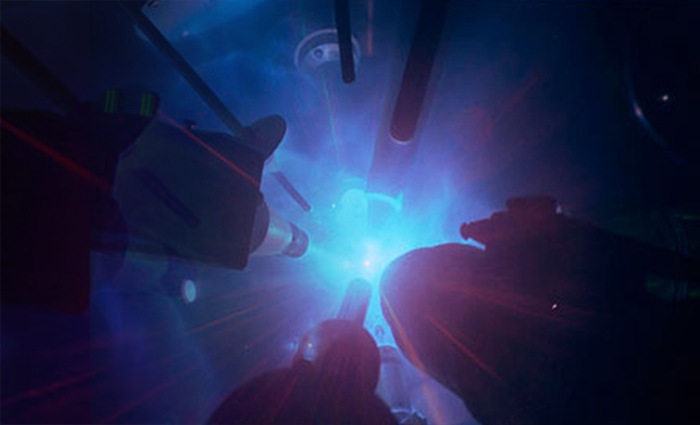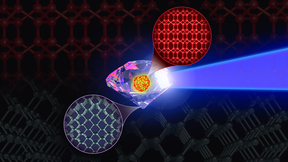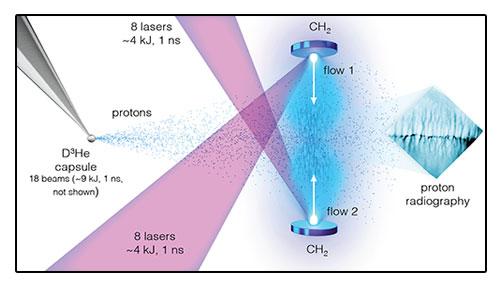Peering into cosmic magnetic fields
 (Download Image)
Inside the Omega Laser Facility’s target chamber during a shot. Experiments at this facility have provided insight into magnetic field generation. Photo courtesy of University of Rochester’s Laboratory for Laser Energetics
(Download Image)
Inside the Omega Laser Facility’s target chamber during a shot. Experiments at this facility have provided insight into magnetic field generation. Photo courtesy of University of Rochester’s Laboratory for Laser Energetics
The generation of cosmic magnetic fields has long intrigued astrophysicists. Since it was first described in 1959, a phenomenon known as Weibel filamentation instability -- a plasma instability present in homogeneous or nearly homogeneous electromagnetic plasmas -- has generated tremendous theoretical interest from astrophysicists and plasma physicists as a potential mechanism for seed magnetic field generation in the universe.
However, direct observation of Weibel-generated magnetic fields remained challenging for decades. In a Nature Physics paper published this week, Lawrence Livermore National Laboratory (LLNL) researchers report for the first time well-developed, oriented magnetic filaments generated by the Weibel mechanism in counter-streaming, collision-less flows generated by high-power lasers.
"Comparison with 3D particle-in-cell simulations and a first-principles theoretical treatment proves that the magnetic field generation in such flows is real, and quite efficient," said lead author Channing Huntington, a physicist at LLNL.
The team’s findings demonstrate the power of the Weibel instability to produce small-scale seed magnetic fields throughout the cosmos, which can be then further amplified to larger scales, creating the ubiquitous magnetic fields that are seen to exist in astrophysical systems. In addition, Weibel-generated magnetic fields may trap plasma ions, creating localized shocks where cosmic ray particles could be accelerated.
The researchers employed protons produced by the implosion of a D-3He (deuterium and helium) capsule that produced single energy at high flux. This high-quality data unambiguously revealed the elusive Weibel filamentation instability, which is a fundamental result that, due to the scalability of this process, will have a strong impact on the thinking of astrophysicists. Additionally, the 3D simulations performed to complement the data utilize cutting-edge techniques in the field of advanced computation, further extending the applicability of this work. These experiments were conducted at the Omega Laser Facility at the University of Rochester’s Laboratory for Laser Energetics.
"It is well-known that a range of magnetic field scales exist in the cosmos, but the origin of these fields has been an elusive question," Huntington said. "Weibel instability has long been theorized as a mechanism to generate these fields, but this work offers the most compelling experimental evidence to date that this is indeed possible."
Having developed a robust experimental platform and confirmed the generation of Weibel filamentation, the team envisions a broad range of follow-up experiments on OMEGA to test the magnetic field generation under conditions that are relevant to astrophysical systems (for example, in the presence of a pre-existing magnetic field, which may modify the instability growth). They also have begun a set of experiments at LLNL’s National Ignition Facility, where larger, faster plasma flows are believed to produce even higher fields and the Weibel mediated shock formation will be fully mature. These experiments will reach conditions not previously achieved in a laboratory setting.
The research was conducted in collaboration with an international team from Japan, the United Kingdom, Massachusetts Institute of Technology, Princeton, France, the University of Rochester and the University of Michigan.
Co-authors on this paper include Frederico Fiuza, J. Steve Ross, Matthew Levy, Chris Plechaty, Bruce Remington, Dmitri Ryutov and Hye-Sook Park of LLNL; Alex Zylstra, Chikang Li and Richard Petrasso of the Massachusetts Institute of Technology; R. Paul Drake and Carolyn Kuranz of the University of Michigan; Dustin Froula of the University of Rochester’s Laboratory for Laser Energetics; Gianluca Gregori and Jena Meinecke of the University of Oxford; Nathan Kugland of Lam Research Corporation; Taichi Morita, Youichi Sakawa and Hideaki Takabe of Osaka University’s Institute of Laser Engineering; and Anatoly Spitkovsky of Princeton University.
Contact
 Breanna Bishop
Breanna Bishop
[email protected]
(925) 423-9802
Related Links
Nature PhysicsThe paper
Tags
Lasers and Optical S&TLasers
National Ignition Facility and Photon Science
Featured Articles








